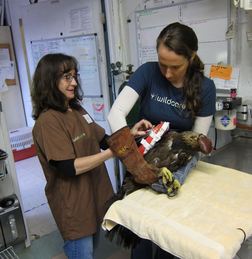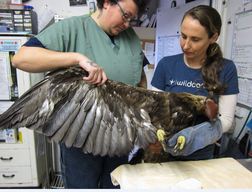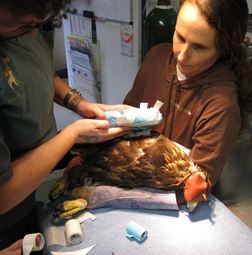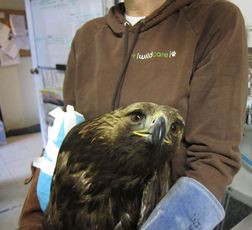
WildCare's Wildlife Hospital treats nearly 4,000 ill, injured and orphaned wild animal patients from over 200 species every year. This is one patient's story.
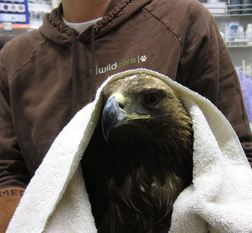
But seeing one on the ground, at eye level, and one that doesn't fly away must be truly startling.
That happened to this bird's rescuer as he walked his dogs in an area of trails off Highway 37 at the north end of the San Francisco Bay. The enormous eagle sat on a log, unmoving and hunched, but definitely alert. Expecting the huge wings to open and flap at any moment, the man walked closer. As he got closer still, and the bird still didn't move, he made the decision to capture him and bring him to WildCare. Obviously something was very wrong with this eagle.
Intake at WildCare
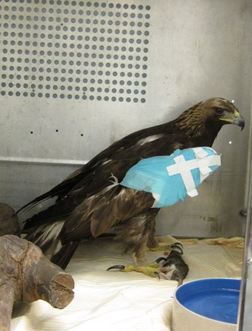
His right wing had been broken, maybe as much as weeks earlier. This valiant bird had been deprived of flight and any means of hunting, but had somehow survived on the ground, eating carrion and anything else he could scrounge. Medical Staff noted during the intake exam that the bird's crop was actually full of semi-putrid meat, indicating that he had recently come across a large carcass and eaten his fill. Perhaps a full belly had contributed to the lethargy that made him so easy to capture.
The fracture to the wing was severe, and it had already started to heal in its misaligned position. Fortunately for this magnificent eagle, the healing had not progressed so far that the wing was permanently damaged. At least Medical Staff hoped not.
The wing was wrapped into the proper healing position and the bird was left for the night in a warm enclosure to begin his recovery. The next day, he hadn't eaten, so Medical Staff brought him into the Med Room to be tweezer fed. The bird needed to get his strength up, as his physical therapy regimen was due to begin soon. A bird with a broken wing needs time for the fracture to heal, of course, but keeping the entire wing wrapped tightly causes contracture of the joints, tendons and muscles of the wing. Physical therapy is required to keep the wing limber while it heals.
Eagle Physical Therapy
Physical therapy on wildlife patients must be done carefully and with great skill. The animals we treat can't, obviously, verbally tell us when something hurts, nor will they, as domestic pets do, indicate pain in an obvious way. A wild animal's survival depends on not showing pain or injury, which makes manipulating an injured joint to the point of maximum extension a careful balancing act.
Fortunately WildCare's Medical Staff has extensive experience with physical therapy on birds of all sizes, and Nat Smith, RVT was ready to work on this eagle. WildCare Director of Animal Care, Melanie Piazza held him to keep his inch-long talons safely controlled.
When manipulating the wing, it is important to stabilize both the joint behind and the joint in front of the injured area to prevent further injury during therapy. This requires firm, gentle pressure and not an inconsiderate amount of hand strength.
Watch in the video below as Nat gently extends the wing and holds it, just at the point of maximum extension, before returning it to its original position. The eagle is not under sedation for the procedure, but the use of a falconer's hood dramatically reduces his stress. Birds of prey are incredibly visual creatures, and removing the stress of seeing the frightening humans and his bizarre surroundings makes the massive eagle pliant and comparatively relaxed in his handler's arms.
The fracture was healing well and, over the course of several physical therapy treatments, the wing gradually loosened and movement became easier. The bird's appetite, massive in proportion to his body size, also improved and he started gaining weight.
As of this writing, the wing has healed to the point of no longer needing to be firmly wrapped and strapped to the bird's body. It is truly astonishing how quickly wild animals heal, and this eagle is no exception. He will spend a few more days under observation in a small aviary at WildCare, before transferring to the 150-foot aviary at our sister center, Sonoma County Wildlife.
In WildCare's current location in downtown San Rafael, we simply don't have the aviary space to give a bird of this size the room he needs to rebuild his flight strength. Our future new site, just ten minutes up the road but on nearly five acres of land, will allow us to keep magnificent patients like this one on-site for the duration of their rehabilitation.
With luck, this beautiful Golden Eagle will make a complete recovery and be able to take his rightful place in the open skies once more!
WildCare is a 501(c)3 nonprofit organization supported almost entirely by private donations and individual memberships. Visit us online at wildcarebayarea.org.

